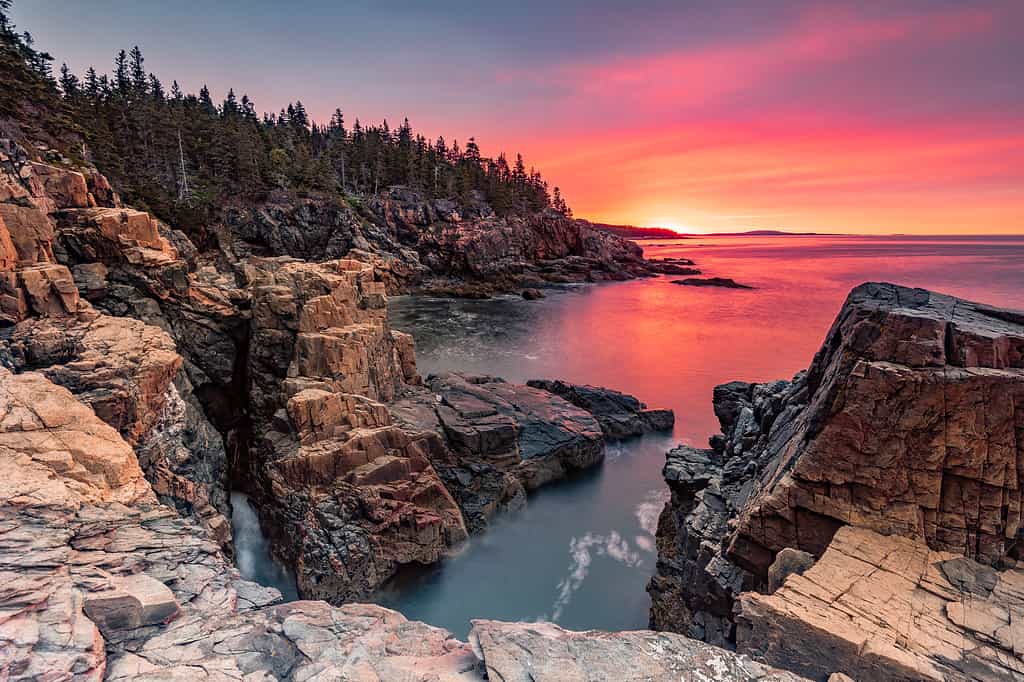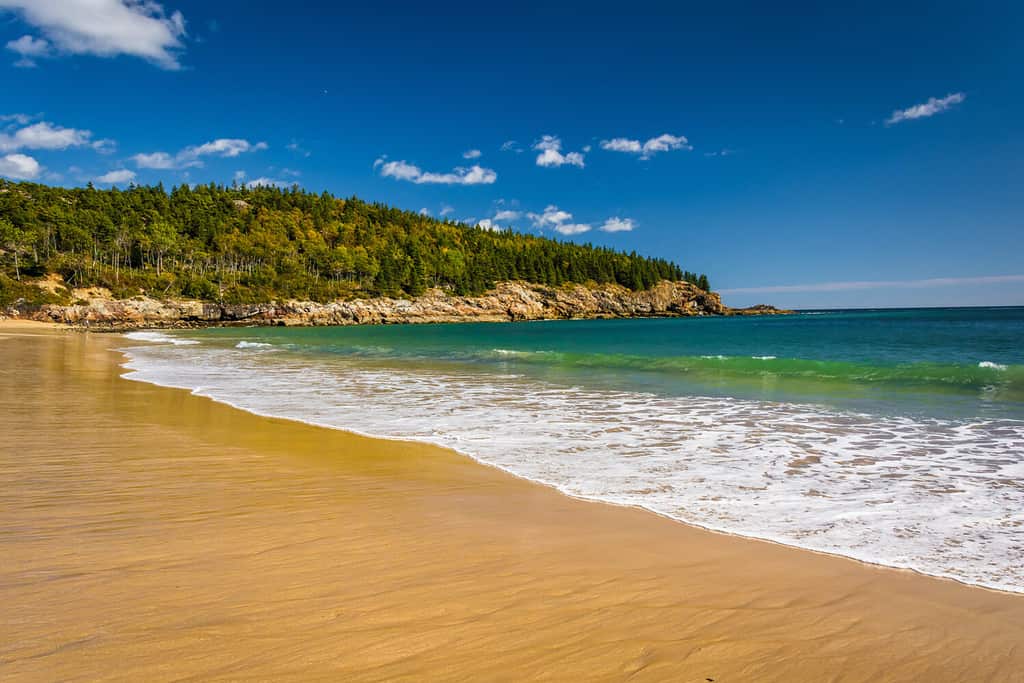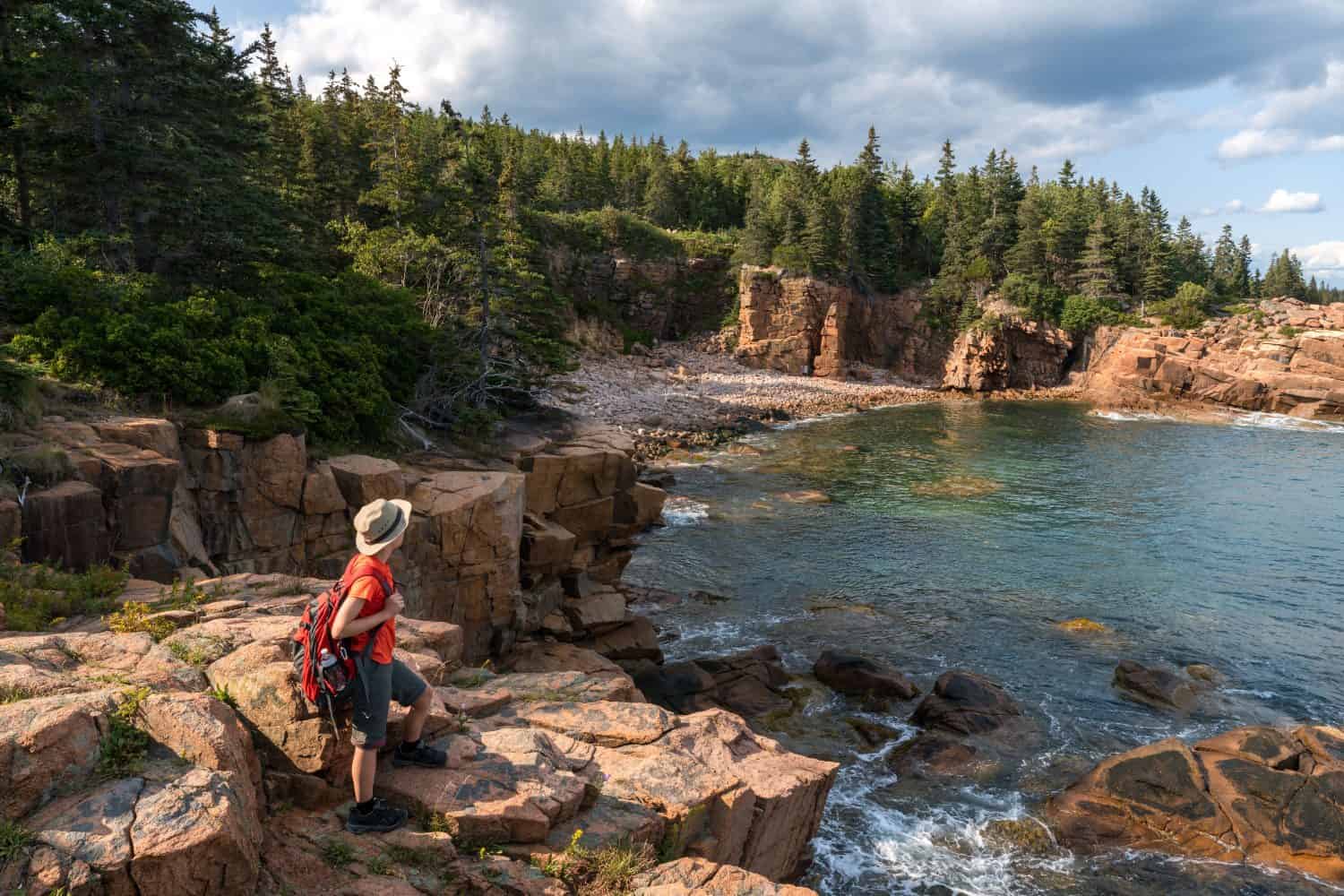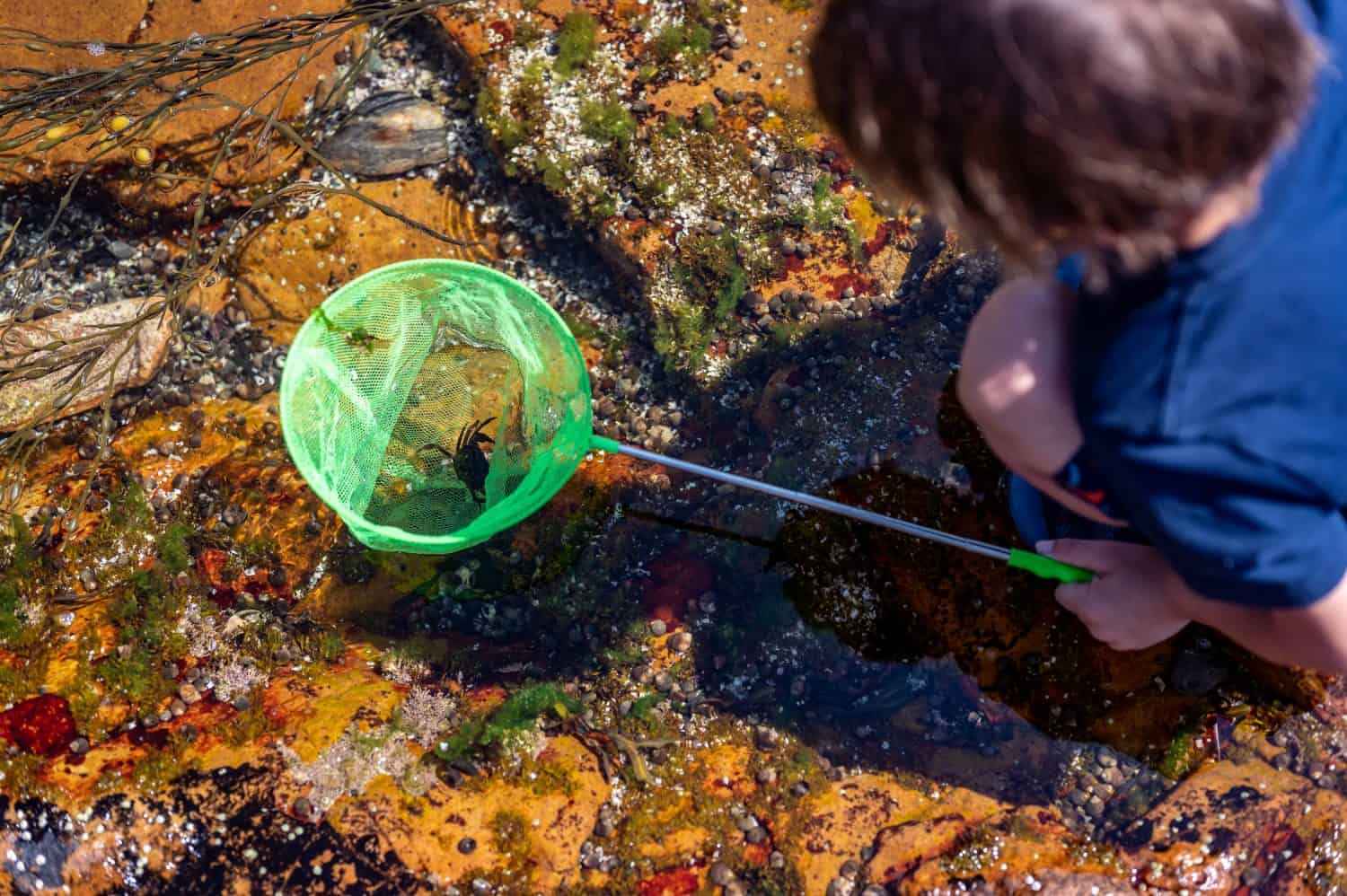Acadia National Park is on the Eastern Sea Border on Maine’s coastline. It’s a 47,000-acre space encompassing Mount Desert Island plus parts of Isle de Haut and the Schoodic Peninsular. It’s one of Maine’s few national parks and receives four million annual visits. Here are 10 reasons Acadia National Park needs to be on your bucket list.

Acadia National Park receives four million visits annually.
©Alexey Stiop/Shutterstock.com
1. Acadia National Park’s Unique Natural Features
Acadia National Park is rich in unique features. It has 26 mountains between 284 and 1,530 feet tall. The most prominent is Cadillac Mountain, the tallest mountain on the United States’ eastern coastline. On its summit, from October to March, visitors can watch the first light rays hit the United States.
Isle de Haur
Only accessible by mail boat is Isle de Haut, a picturesque island with campsites and hiking trails.
Thunder Hole
On the coastline sits a natural inlet combining large ocean waves with a stone crevasse. With each wave, a booming sound reminiscent of thunder echoes along the coast.
Sand Beach
Acadia National Park’s coastline is generally rough and rugged, but it pauses for a moment at Sand Beach, relaxing into a sheltered, sandy stretch of family-friendly coastline. It’s popular with picnickers and is a good hiker stopping point because it’s just off the Ocean Path Coastal Trail.
Great Long Pond
If fishing, kayaking, and canoeing are your thing, head to Mount Desert Island’s Great Long Pond, a 113-foot-deep by four-mile-long body of water that’s packed with fish.
Schoodic Peninsula
A good bet for solitude, the quieter Schoodic Peninsula boasts dramatic views of the ocean and mountains. It’s a quieter spot but no less epic. Bike the 8.3-mile Schoodic Loop with only a few others on the path.
Bubble Rock
The most famous rock in Maine is undoubtedly Bubble Rock, a 14-ton rock hanging on the edge of the 768-foot South Bubble Summit. Moved here by glacial flow thousands of years ago, it’s possibly the park’s most visited feature.
2. Breathtaking Landscapes

Acadia National Park is full of thriving ecosystems, from rocky coastlines to wetlands marshes.
©Harry Collins/iStock via Getty Images
Acadia National Park’s breathtaking landscapes are among some of the United States’ most varied. The underlying geology is a history lesson from Baron mammoth mountains to exposed granite cliffs, rocky headlands, domes, and cobbled beaches. This unusual glacial park includes meadows, lakes, streams, wetlands (over 20% of the park is wetland), forests, and fascinating coastlines.
One of Acadia Park’s best attributes is accessibility, and more on that later, but a historic road winds its way throughout the park.
3. Incredible Abundance of Wildlife

American black bears (
Ursus americanus) patrol Acadia National Park.
©Frank Fichtmüller/iStock via Getty Images
With such a varied array of ecosystems, it’s no surprise Acadia’s National Park’s wildlife thrives in abundance.
Birds
Acadia National Park’s ponds and wetlands provide a stopping point for migrating birds traveling the Atlantic Flyway and house native birds. Of particular note are golden eagles, bald eagles, and nesting peregrine falcons.
Mammals
North American black bears, coyotes, foxes, moose, weasels, lemmings, whitetail deer, snowshoe hares, and porcupines are just a few of the 37 mammal species taking advantage of this epic park’s ecosystems.
Reptiles
Both common snapping turtles and eastern painted turtles inhabit Acadia National Park alongside five snakes:
- Milksnake
- Smooth snake
- Redbelly snake
- Ring-necked snake
- Eastern garter snake
There are no venomous snakes in Acadia.
Amphibians
Eastern newts, American toads, five frogs, pickerels, and four salamander species inhabit the wetlands and damp forest areas.
Marine Animals
Abundant whales and seals frequent Acadia Park’s headwaters, and whale-watching trips are popular.
And last but not least, because fishing is a popular activity in Acacia National Park, the fish! Common species here are American eels, pumpkinseed, banded killifish, and golden shiners that thrive in its clear water. Other common fish include tasty brook trout and rainbow smelt.
4. Cultural and Historical Significance

Acadia National Park features several historical landmarks.
Image: Zack Frank, Shutterstock
©Zack Frank/Shutterstock.com
Samuel de Champlain arrived on these shores in 1604 from Europe and mapped the area, noting its mountains and tree lines. This expedition was named Isle de Monts Desert, but they were not the first humans there. The Wabanaki Native Americans have inhabited this area for 12,000 years.
In 1916, President Wilson gave the area federal status and named it Sieur de Monts National Monument on July 8. However, this beautiful landscape had many names! In 1919, it was renamed Lafayette National Park, and then, in 1929, what we now as Acadia National Park.
John D. Rockefeller, Jr. built 50 miles of the carriageway from 1915 to 1933, which is still used today. In summer, rangers lead cultural and natural history tours for adults and children, including boat cruises and peregrine falcon viewing.
5. Outdoor Recreation Opportunities

Sand Beach in Acadia National Park is perfect for picnics.
©Jon Bilous/Shutterstock.com
Acadia is an outdoor playground filled with opportunities to enjoy outdoor life. Over 120 miles of well-maintained forest and mountain treks, one-way bike trails (rent a bike in Bar Harbor), numerous campsites, horseback riding, narrated bus tours, and coastline explorations by kayak or sightseeing boats.
In winter, snowshoe hikes, snowmobiling, and ice fishing on ponds are popular activities; then, motor vehicle touring opens in April. The scenic 27-mile Park Loop Road is popular with visitors.
6. Adventure and Thrills in Acadia National Park

Acadia National Park offers wildlife-rich hiking with spectacular scenery.
Image: Romiana Lee, Shutterstock
©Romiana Lee/Shutterstock.com
Perennially popular activities include wild camping, whale-watching tours, and wildlife-rich hiking. Still, some special activities you won’t find elsewhere include a step back in time, a horse-drawn carriage ride on historic trails, and the park’s annual Acadia Night Sky Festival, which hosts researchers, photographers, and speakers.
7. Accessibility and Visitor Amenities

Acadia National Park strives to be accessible to all visitors.
©24K-Production/iStock via Getty Images
First-time visitors should start at the Hulls Cove Visitor Center, which houses information about park areas and activities. Alternatively, head to the Rockefeller Hall Welcome Center on the Schoodic Peninsula.
Visitors aged 16 and above need a park entrance pass displayed on their windshield at all times, and although pets are welcome, they must remain on a leash at all times.
The park strives for accessibility, there’s a wheelchair-adapted carriage tour, and the free Island Explorer bus is wheelchair accessible. Wheelchair users can call from a park’s many phone stops for pick-up.
8. Acadia Park’s Educational Value

Acadia National Park offers many educational opportunities.
Image: Miro Vrlik Photography, Shutterstock
©Miro Vrlik Photography/Shutterstock.com
Acadia National Park is a beautiful natural resource packed with educational value.
The ecosystems and rich wildlife provide just a portion of the learning experiences here. Please stop by the well-equipped visitor centers to learn all there is to know about this incredible park and its history.
- The main visitor center at Hulls Cove
- Nature center at Sieur de Monts
- Information center on Thompson Island
- VIsito Center at Village Green in Bar Harbor
- Historical museum in Islesford on Little Cranberry Island
- Rockefeller Welcome Center on the Schoodic Peninsula
9. Conservation and Sustainability Efforts

Acadia National Park strives to protect its varied ecosystems.
Image: Lost_in_the_Midwest, Shutterstock
©Lost_in_the_Midwest/Shutterstock.com
Climate change, pollution, tourism, and invasive species affect Acadia National Park’s varied ecosystems and wildlife. The National Park Service and the Friends of Acadia sustainably manage the park.
10. Memorable Experiences

From October to March, Cadillac Mountain is the first place sunlight touches in the United States.
©Christopher Georgia/Shutterstock.com
Visitors recommend watching the sunrise on Cadillac Mountain. It’s one of the park’s most memorable experiences because, between October and March each year, it’s where the first ray of sunlight touches the United States. It’s nothing short of magical. However, if you’re not a morning person, hike to 14-ton Bubble Rock and marvel at its incredible balancing act.
Thank you for reading! Have some feedback for us? Contact the AZ Animals editorial team.







